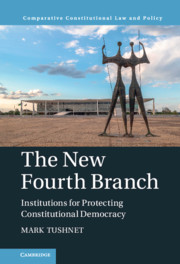Book contents
- The New Fourth Branch
- Comparative Constitutional Law and Policy
- The New Fourth Branch
- Copyright page
- Contents
- Acknowledgments
- 1 Introduction
- 2 Why a Fourth Branch?
- 3 Why a Fourth Branch?
- 4 Design Issues in General
- 5 Design Principles in Practice
- 6 Anti-corruption Investigations
- 7 Electoral Commissions
- 8 Audit Agencies
- 9 Conclusion
- Index
3 - Why a Fourth Branch?
The Functional Logic
Published online by Cambridge University Press: 20 August 2021
- The New Fourth Branch
- Comparative Constitutional Law and Policy
- The New Fourth Branch
- Copyright page
- Contents
- Acknowledgments
- 1 Introduction
- 2 Why a Fourth Branch?
- 3 Why a Fourth Branch?
- 4 Design Issues in General
- 5 Design Principles in Practice
- 6 Anti-corruption Investigations
- 7 Electoral Commissions
- 8 Audit Agencies
- 9 Conclusion
- Index
Summary
As we have seen, Kelsen identified a fourth function of government, preservation of the constitution, and assigned it to a new institution, the constitutional court. The reason was that in a party-political world neither the legislature nor the executive could be trusted to perform the function except under specific, and probably unusual, conditions. Absent those conditions, legislatures controlled by one party would not investigate threats to the constitution posed by an executive of their own party, and would exaggerate the threats posed by an executive of the opposition party – and conversely, with executive oversight of threats posed by the legislature. Call this a problem of conflict or convergence of interest.
- Type
- Chapter
- Information
- The New Fourth BranchInstitutions for Protecting Constitutional Democracy, pp. 25 - 41Publisher: Cambridge University PressPrint publication year: 2021

